
Adjusting (or aiming) Signals
Ground Masts
Bracket Posts
Cantilever
Signal Bridges
Dwarf Installations
Overhead and/or Ceiling Installations
Side and/or Wall Mounted
Mounted onto Road Overpasses
Mounted on Catenary Supports
Other Mounting Options

Adjusting (or aiming) Signals
Ground Masts
Bracket Posts
Cantilever
Signal Bridges
Dwarf Installations
Overhead and/or Ceiling Installations
Side and/or Wall Mounted
Mounted onto Road Overpasses
Mounted on Catenary Supports
Other Mounting Options
Introduction
This section explores the various methods in which signals are mounted to whatever it is that supports them.In every installation, the signals, once installed, have to be aimed and/or adjusted, so the engineers can see them properly for the distance they were designed for. Signals are adjusted in both the X and Y axis', elevation (up and down), and rotating. Most high signals are designed to be seen at a distance. Dwarf signals are (mostly) designed for being seen close up, and if you look at most dwarf installations, you will see that the signals are placed at an "up" angle. Signal designers also devised a method whereby engineers could see high signals close-up, by placing a Fresnel section at the bottom of the lens, which would divert a portion of the light downwards.
There are many methods used to adjust a signal for elevation, but for moving the signal left to right really only involves rotating the signal to point in the proper direction, and then tightening the clamps or bolts.
In the picture below, it clearly illustrates one method for adjusting a signal for elevation. The signal "S", is mounted to the top bracket "T". The bottom bracket "B" mounts to the top of the mast "M". To the right at "A", is an adjustment bolt, that when the nuts are moved, or adjusted, will move the upper bracket in relation to the bottom bracket. There are two sets of two nuts to make the adjustment, and then tighten to keep the alignment in place. To rotate the signal, they would adjust the signal for the direction they want, then tighten the three bolts for the bottom bracket, then they can adjust the elevation of the signal and tighten the "A" and "P" bolts.
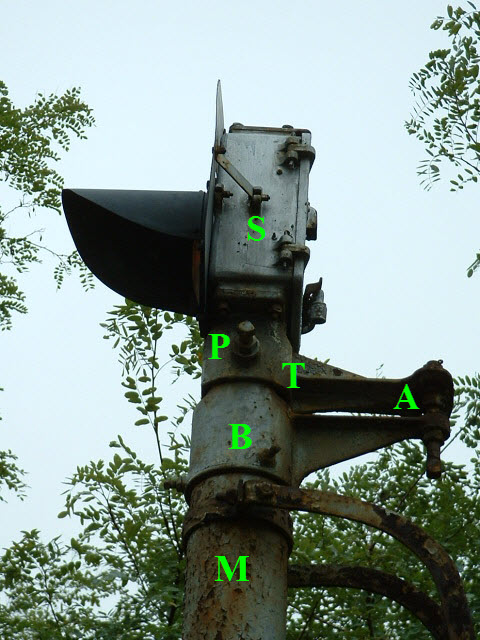
The picture below illustrates a updated version of the elevation adjustment for top of the mast installations.
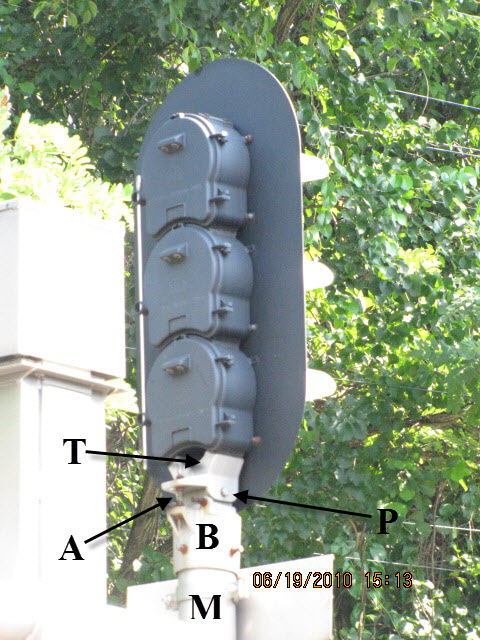
Below is a picture of a side mounted searchlight installation. In addition to the already familiar designations, "U" is for the U-bolts, and "R" is for a bolt that can be loosened to slightly rotate the signal once the U-bolts have been tightened.... consider it a fine tuning adjustment.
This picture also illustrates US&S's provisions for aligning the signal. "S3" is a hole placed in the background so the signalman can use "S2" and "S1" for sighting. S1 typically has a set of crosshairs for looking through the hole at S2 to see where the signal is aimed. Searchlight signals needed more accurate aiming because they typically had a narrowly focused beam width, some as small as 5 degrees. Because the beam was more focused, they could typically been seen at further distances, even though they usually employed 10 watt bulbs instead of the more common 25 watt bulbs.
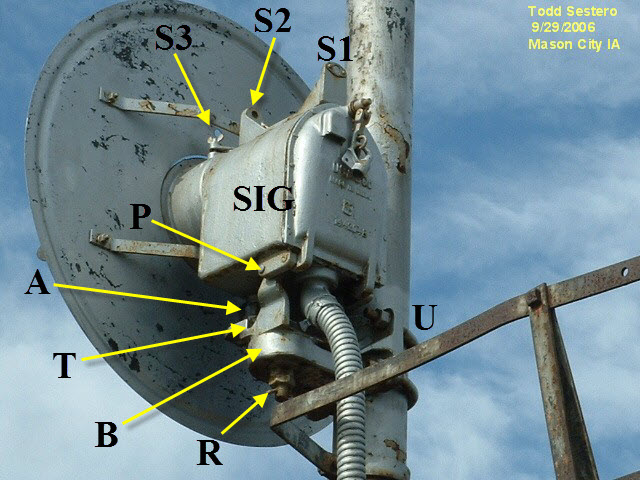
A ground mast installation put one set of signals off to the side of the track. In the old days before the feds relaxed their standards, all signals had to be to the right of the track it governed. I'm not sure when, but maybe around 2000 or so, they started allowing signals to be placed to the left side of the track, thereby allowing the railroads to have a signal installation with only one mast for both directions instead of two.
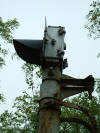
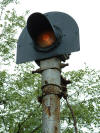
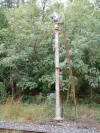
A single color colorlight signal in Durham NC in a top of mast
configuration. The elevation adjustment mechanism is plainly visible.
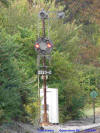
A single CPL signal in Gaithersburg MD.
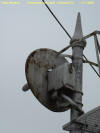
A GRS searchlight signal showing the mounting bracket clamped
to the mast with two u-bolts. The bracket is curved down for some reason.
The elevation adjustment is under the signal where you can't see it in this
photo.
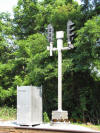
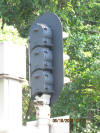

A newer installation in
Boyce VA. This is a
few miles from the Berryville bracket post pictures below. This is a
location where they would have had a separate N&W CPL signal on each side of the
track. The box below the mast has a winch for lowering and raising the
signal for maintenance work.
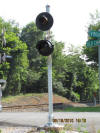
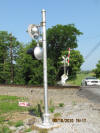

Crossing signals count too. Here is a set in Boyce VA.
Everything here is attached to the mast with U-bolts.

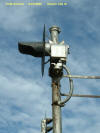
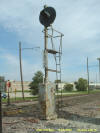
A single US&S searchlight signal mounted to the side of the
mast in Mason City
IA.
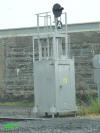
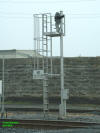
Colorlight installations on the CP near SK yard in Buffalo.
Notice, even though they didn't have to, the installation on the right still
uses a mounting arm to place if off to the side of the mast.
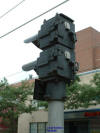
A signal on the
Buffalo NY light
rail system. Notice there is no provision to adjust the elevation of this
signal, for it is already mounted on a pole that places it at the proper height
for the operators.

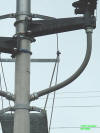
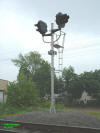
A colorlight signal installation east of Buffalo NY, where the
signals for both directions of this single track mainline have been placed on
one mast. This CP line heads down to Binghamton NY
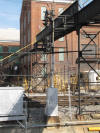
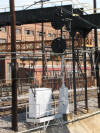 N&W CPL signals in Roanoke VA.
N&W CPL signals in Roanoke VA.
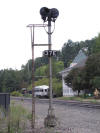


A trio of pictures from
Ann Arbor MI,
where back to back searchlight signals are placed on one mast.
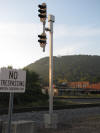
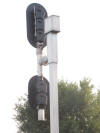
A newer colorlight installation in
Roanoke VA on the
ex N&W. The supports slide up and down for easier bulb replacement.
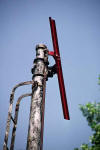
A tilting target signal mounted to a mast in Bay City MI, photo by Dave Ingles.
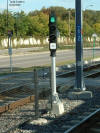


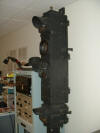
Mast mounted transit signals on the
Minneapolis Light
Rail System. Notice how a signal can be secured at the top of a signal
in the right pix.
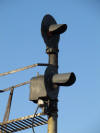
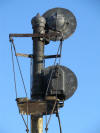
A GRS searchlight and fixed
signal, mast mounted, at a diamond in
Kalamazoo MI.


A mast mounted searchlight signal in
Durand MI.


Mast mounted tri-light style colorlight signal in
Houston TX.


Mechanically operated semaphores mounted to a mast.
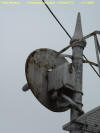

A GRS searchlight at Settegast
Yard in Houston
TX.
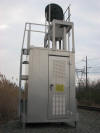
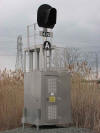
I guess this counts as a mast installation, altho the short
mast mounts on top of the equipment cabinet. In
Wilmington DE.
Bracket Post signal installations were used when the railroads needed more than one set of signals at a particular location, and only wanted to use one mast. The reason for doing so could be because of cost or space limitations along the right-of-way.
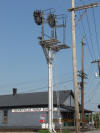

A typical N&W bracket post installation in
Berryville VA.
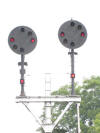
A pair of N&W style CPL signals mounted to a bracket post in
Bedford VA.
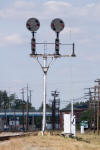
A cantilever installation in Ohio with three signals, one
being a doll post. Photo by Eric Davis.
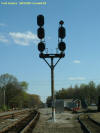
Bracket post signals in
Doswell VA.
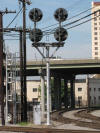 N&W CPL's on bracket post installation in downtown
Roanoke VA.
N&W CPL's on bracket post installation in downtown
Roanoke VA.
A cantilever signal bridge is a structure designed to place signals OVER the track they govern, instead of off to the side as with a ground mast or a bracket post. In one sense, it could be considered half of a signal bridge which spans the entire right-of-way with two supports since the cantilever installations only require one support structure.

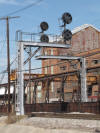
A pair of cantilever placed signals in downtown
Roanoke VA
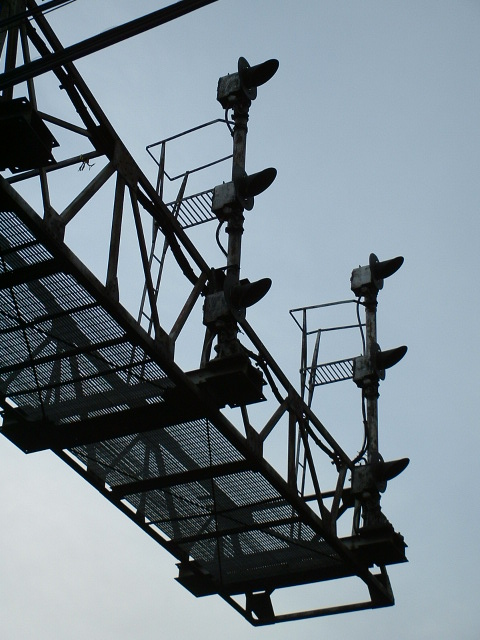
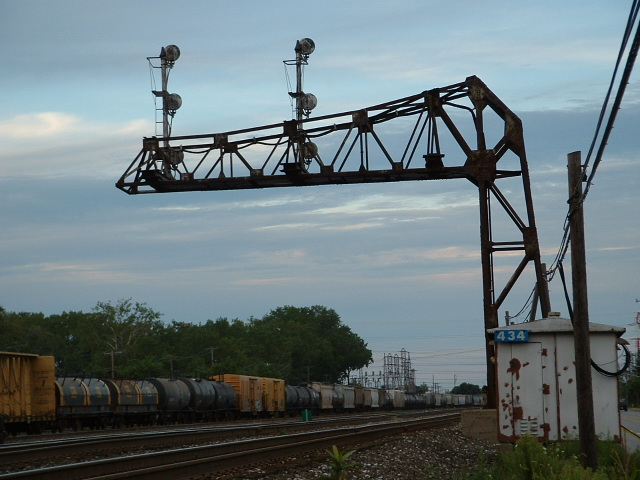
A beautiful old cantilever signal installation on the old New
York Central system tracks on the east side of Buffalo as you approach the yard.
Unfortunately for us, CSX has replaced the cantilever bridge with a nice new
standard design aluminum signal bridge, maybe around 2012?
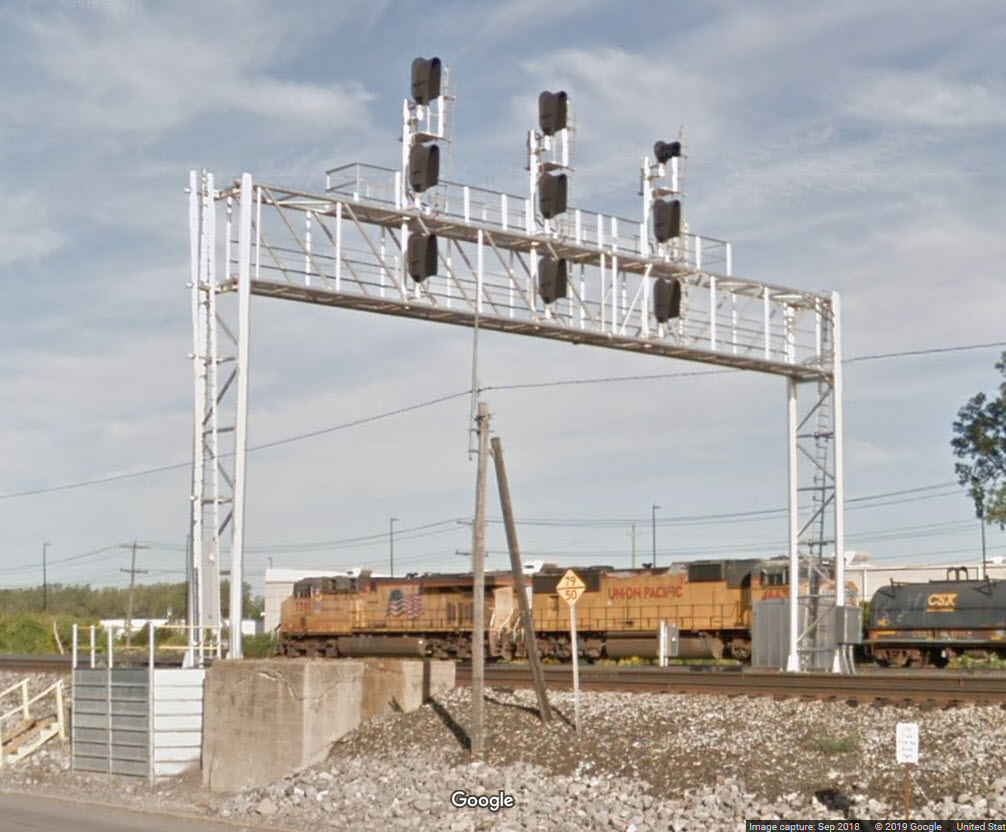
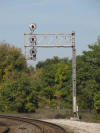

Searchlight signals mounted to a cantilever bridge in
Battle
Creek MI.
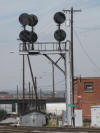
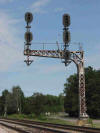

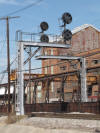 N&W CPL's on cantilever bridges in downtown
Roanoke VA.
N&W CPL's on cantilever bridges in downtown
Roanoke VA.
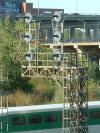
Searchlight signals on the CN in Toronto ON.
A signal bridge is just that, a structure that is similar to a bridge in construction, and spans the entire right-of-way, with a footing and support on each side of the R-O-W. There are about as many versions of signal bridges as there are installations, although most railroads tended to have a standard set of drawings that kept the designs pretty much the same all over the system. In the case of standard drawings, the specs would change only when they came up with a newer, more efficient, and probably cheaper way to build the structures.

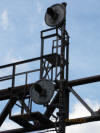

A simple signal bridge on the west side of
Binghamton NY.
While it appears that they could have done this installation with a signal off
to the side, there was probably another track at one time, and more signals on
the bridge. These old signals are now mostly gone, having been replaced
with newer colorlight installations by NS in 2011.
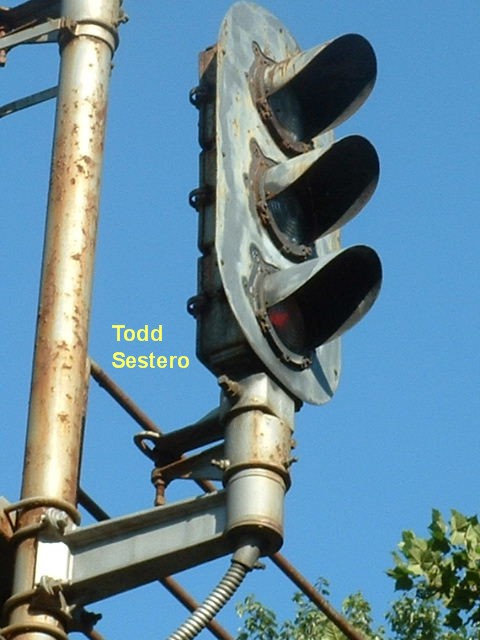

On CSX's/ex NYC mainline west of
Batavia NY, where
there were once 4 tracks.

Classic SR signal bridge in NOVA (NOrthern VirginiA).
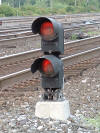

GRS dwarf searchlight signals on the ex NYC, now CSX line east
of Buffalo.
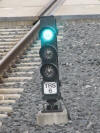
Dwarf colorlight on the
Charlotte Light Rail System.
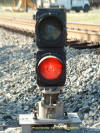
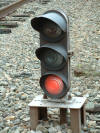
A couple of dwarf colorlight signals in
Doswell VA.

Dwarf colorlight signal in
Lansing MI.
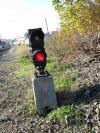
Dwarf colorlight signal in
Kalamazoo MI,
on a crooked concrete base, oooops, never mind, that was me :-)


Dwarf searchlight signals in
Durand MI.
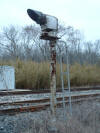
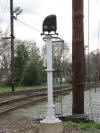
Not sure if we consider this a dwarf installation or not since
they are mounted about 6ft up on a mast, anyways, the left one is at Pierce
Junction in
Houston TX, the other is at
Perryville MD at
the wye.
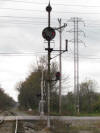
A B&O CPL dwarf mounted to the side of a standard signal mast,
used to control the siding. Near the Wilmington
& Western RR.
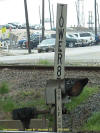
A dwarf searchlight signal at tower 87/Englewood Yard in
Houston TX.

An N&W dwarf CPL in downtown
Roanoke VA.
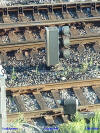


A couple of different dwarf searchlight signal installations
on the CN in Toronto ON.
Overhead and/or Ceiling Mounted
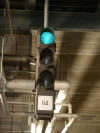
So far, this is the only ceiling mounted signal I have been
able to get a picture of, on the
Minneapolis Light
Rail System.
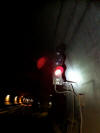
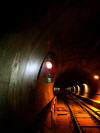
Two examples of transits signals mounted to the inside a
tunnel wall on the
Buffalo NY light rail system. They use a simple angle iron support
since they have to be mounted close to the wall, and are not subject to wind and
weather.
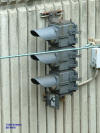
A Buffalo light rail signal mounted to the wall just before
going into the tunnel. The signal is mounted to the wall using Unistrut
brackets, and then a simple L-bracket mounted to to the Unistruts.
Mounted onto Road Bridges/Overpasses
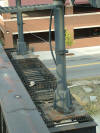
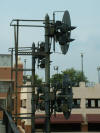

Here we're in Roanoke VA with some N&W CPL signals, at the 4th Ave bridge.
These signals are now signal bridge mounted.
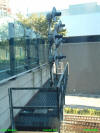
This set of searchlight signals is in Toronto ON, near the
station.
In electrified territory, it was common for the railroads to use the existing catenary structures for mounting signals to. And why not, it saved money.
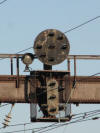


Signals on the Harrisburg line in
Lancaster PA
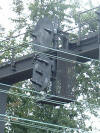
A close-up of an Amtrak PCL signal (an ex Pennsy PL signal) in
Halethorpe MD shows how, since the signals are designed to be mounted to a pole,
or mast, that a mounting bracket for the mast has to be mounted to the cantenary
support in order to mount the mast.

On the northbound approach to the bridge over the Susquehanna
River in Havre
de Grace MD, is this "trilight" colorlight signal using LED's.


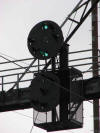
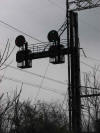
Additional PCL installations on the NEC in
Wilmington DE.
Pedestal Signals on Catenary Supports
Although mounting signals on catenary support structures is commonplace in electrified territory, this is a very specific installation. One of only two places I am aware of this type of installation is on the north side of the Wilmington DE Amtrak station, and in the Baltimore station/B&P Tunnel area. These two pedestal signals shown below are the first two signals out of the Wilmington station heading north on the corridor. The signals are mounted on top of a short 18 or 24 inch long mast, similar to other signals that are mounted on signal bridges.
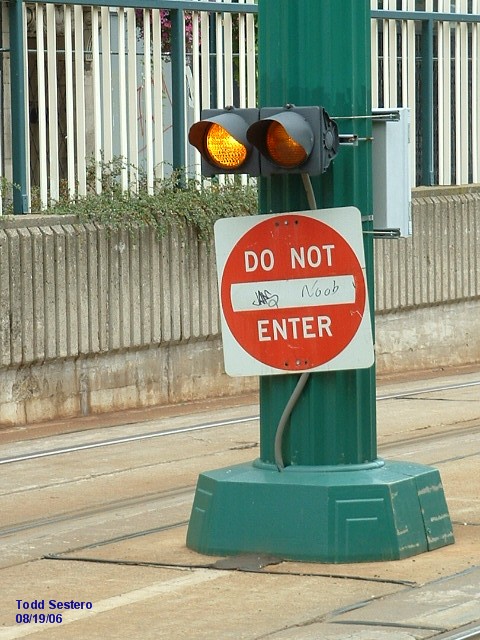
These alert/attention signals are at the entrance to the
tunnel on the Buffalo
NY light rail system so that drivers of cars don't go down the trolley
tracks. They are mounted to the catenary pole using Unistrut brackets.
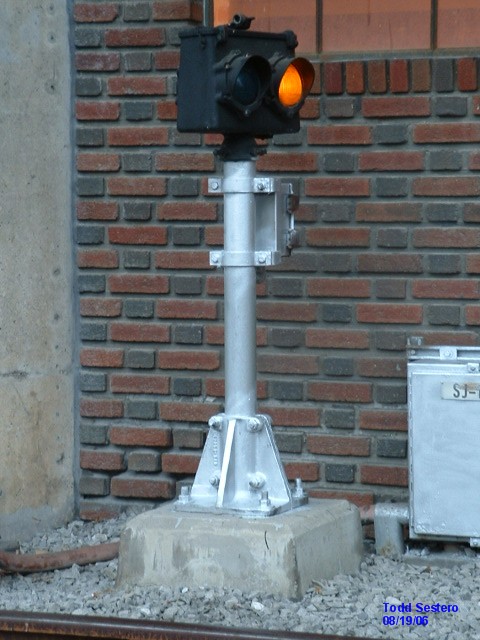
Again in Buffalo, we see a yard signal placed on a short mast
with a standard cement and cast signal base.
Disclaimers:
I love trains and I love signals. I am not an expert.
Please Note: Since the main focus of my two websites is railroad signals, the railfan guides are oriented towards the signal fan being able to locate them. For those of you into the modeling aspect of our hobby, my indexa page has a list of almost everything railroad oriented I can think of to provide you with at least a few pictures to help you detail your pike.
If this is a railfan page, every effort has been made to make sure that the information contained on this map and in this railfan guide is correct. Once in a while, an error may creep in..... :-)
My philosophy: Pictures and maps are worth a thousand words, especially for
railfanning. Text descriptions only get you so far, especially if you get lost
or disoriented. Take along good maps.... a GPS is OK to get somewhere, but maps
are still better if you get lost! I belong to AAA, which allows you to get
local maps for free when you visit the local branches. ADC puts out a nice
series of county maps for the Washington DC area, but their state maps do not
have the railroads on them. If you can find em, I like the National Geographic
map book of the U.S..... good, clear, and concise graphics, and they do a really
good job of showing you where tourist type attractions are, although they too
lack the railroads. Other notes about specific areas will show up on that page
if known.
Pictures and additional information is always needed if anyone feels inclined to
take 'em, send 'em, and share 'em, or if you have something to add or
correct.... credit is always given! BE NICE!!! Contact info is
here
Beware: If used as a source, ANYTHING from Wikipedia must be treated as being possibly being inaccurate, wrong, or not true.
RAILFAN GUIDES HOMENEW
AUG31/2005, OCT06/2006, JAN10/2014
Last Modified
16-Nov-2019